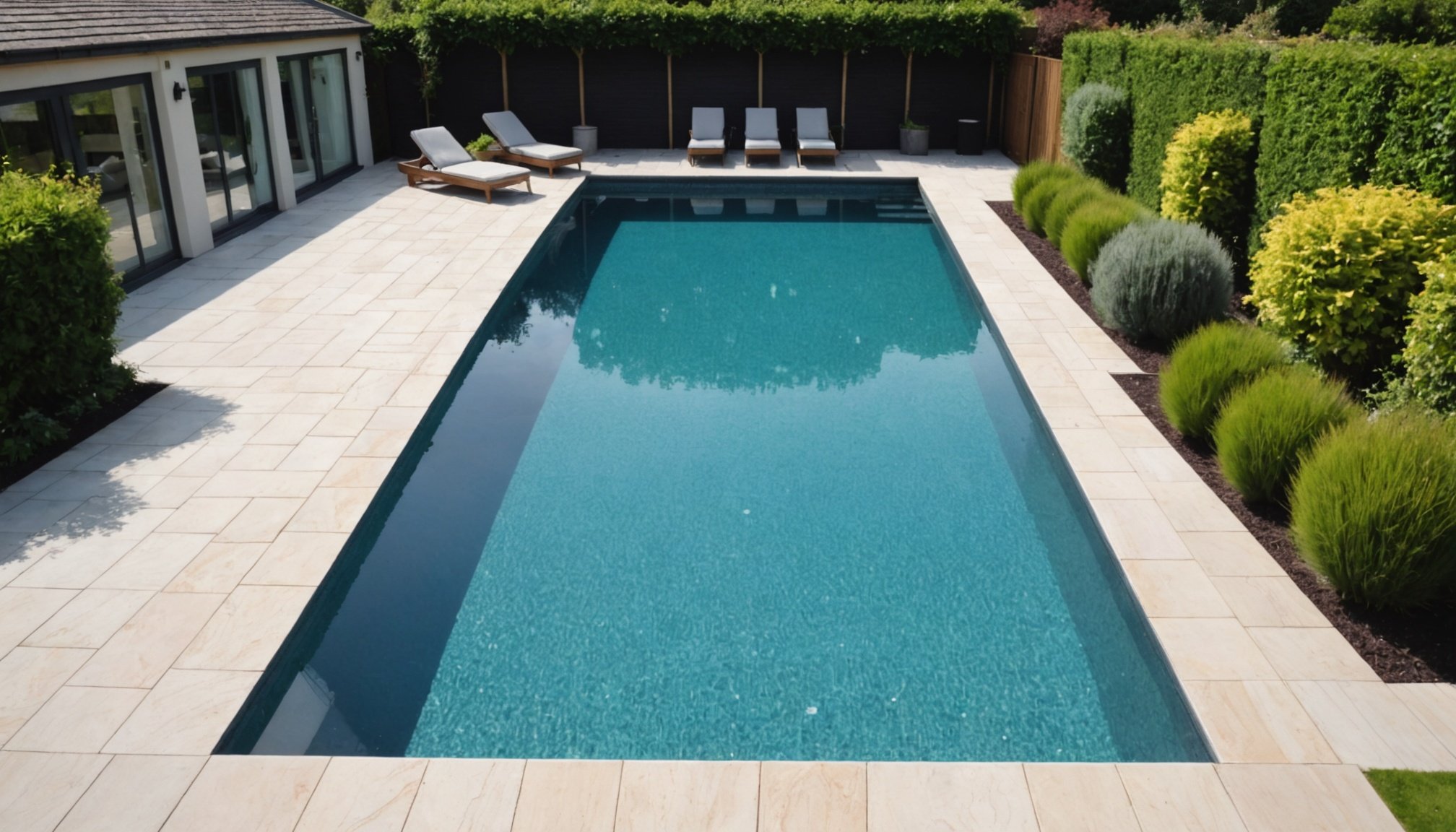Designing a Modern Swimming Pool
Integrating a modern pool design into a UK home requires careful attention to both aesthetics and harmony with the existing architecture. Key elements to consider include the choice of materials, colours, and the overall layout that enhances contemporary aesthetics without overwhelming the space. Highlighting geometry and innovative shapes can accentuate the pool’s design while maintaining a sleek look.
To ensure visual harmony, it’s essential that the pool’s design complements the architecture of the home. Establishing a seamless transition between indoor and outdoor spaces can enhance the home’s visual appeal. Scale and proportion are crucial; a pool that’s too large may dominate the landscape, while one too small might seem out of place. Careful alignment with the home’s dimensions and style ensures that the pool feels like a natural extension of the outdoor environment.
This might interest you : Exploring the Benefits of Variable Speed Pumps: A Guide for UK Home Swimming Pool Owners
In addition, incorporating features such as decks, levels, and steps can add dimensional interest. Using reflective surfaces and clear lines helps to maintain the minimalist vibe typical of modern designs. By aligning these design elements, homeowners can create an elegant and functional swimming pool that enhances their property’s appeal while providing a relaxing retreat.
Aesthetic Considerations
The integration of pool aesthetics plays a crucial role in achieving visual harmony between the pool and the surrounding environment. To reflect contemporary styles, selecting colours and materials that align with modern tastes is beneficial. Neutral tones, such as greys and whites, often enhance the sleekness of the design, while natural materials can create a timeless appeal.
In parallel : Floating fun: the ultimate pool floats and mattress guide
Incorporating landscaping with pool design is essential for a seamless visual transition. Strategically placed plants or water features can soften the boundaries and add depth to the overall appearance. Consider using native plants for minimal upkeep and a landscape that remains vibrant through the seasons.
Lighting is another element that significantly impacts the pool’s visual effect. Opt for subtle yet striking lighting options, such as LED strips or underwater spotlights, to create an inviting ambience in the evenings. Lighting can highlight specific features, effortlessly enhancing the pool’s allure.
Ultimately, the right combination of colours, materials, and lighting can elevate the pool’s aesthetics while maintaining a harmonious connection with the home and its architecture. Homeowners can achieve a cohesive design that resonates with both daytime elegance and nighttime charm by focusing on these aspects.
Materials Suited for UK Environments
Choosing the right pool materials is critical for withstanding the UK’s often unpredictable weather. Durability is a primary concern, as the materials must endure the UK climate, known for its rainy conditions and temperature fluctuations. Concrete and fibreglass are popular choices due to their resilience and adaptability. Concrete pools, though more costly, offer exceptional versatility and longevity. They can be tailored to fit various shapes and sizes, accommodating bespoke designs that align with homeowner preferences. Fibreglass, on the other hand, is less labour-intensive and quicker to install, providing a balance between durability and cost-efficiency.
Locally sourced materials provide not only a sustainable option but also potential cost savings. By selecting materials produced closer to home, transportation expenses decrease, and environmentally friendly choices enhance the overall appeal.
Thermal efficiency is another pivotal consideration. Effective insulation around the pool helps maintain optimal temperatures, reducing heating costs during colder months. Opting for materials with high thermal efficiency, such as insulated tiles or covers, can enhance energy savings and comfort.
Overall, selecting suitable, durable materials, particularly those readily available in the UK, ensures a long-lasting and efficient pool that withstands local environmental challenges.
Installation Advice
When considering pool installation, it is important to understand the construction process to ensure everything flows smoothly. Kickstarting the journey involves thorough site assessment and determining planning permissions, a mandatory step in the UK. It’s crucial to consult with the local council to understand specific requirements or restrictions.
Once permissions are secured, selecting knowledgeable contractors is paramount. Obtain multiple quotes to compare services and costs while verifying each contractor’s track record through established portfolios or client reviews. Having a clear and detailed contract can avert potential misunderstandings during the construction process.
The construction of a modern pool often begins with excavation, a stage where precision is key. Machines are normally hired to dig the selected area, ensuring proper depth and shape alignment. Following this, the installation of the pool shell takes place, typically made from concrete, fibreglass, or vinyl.
Attention should also be paid to plumbing and electrical installations, essential for proper filtration and lighting systems. These should always be handled by certified professionals to adhere to safety and regulatory standards.
Lastly, consider landscaping and decking to finish the project, enhancing aesthetic and functional aspects. This not only provides visual appeal but also creates a harmonious integration with the surrounding environment.
Cost Estimates
When considering building a swimming pool in the UK, understanding potential pool costs is essential for effective budgeting. A detailed breakdown helps manage expectations and finances efficiently. Generally, pool costs vary significantly based on the pool type—such as concrete, fibreglass, or vinyl—materials used, and the complexity of the design. Concrete pools are often more expensive due to their customizability and longevity, whereas fibreglass provides a cost-effective option with shorter installation times. Vinyl pools offer a budget-friendly alternative, though may require more maintenance in the long run.
Several factors influence the total price of pool installation. These include the pool size, materials, location, and additional features like heating, lighting, or covers. Each element contributes to the final budget, so careful attention is required.
To ensure a realistic pool project estimate, create a detailed budget plan incorporating all possible expenses from permits to landscaping. Consulting with professionals can provide clarity on potential costs and help avoid unexpected expenses. A well-thought-out budget not only ensures financial preparedness but also enhances the smooth execution of the project, ultimately leading to a satisfying investment. Prioritising cost-efficient choices can balance quality and affordability in your pool venture.
Maintenance Tips
Proper pool maintenance is crucial for ensuring the longevity and enjoyment of your swimming pool. Regular cleaning and servicing are necessary to maintain water quality and equipment functionality. Essential maintenance tasks include checking chemical levels, such as chlorine and pH, to keep the water balanced and safe for swimming. This should be done at least once a week. Additionally, skimming the pool’s surface to remove debris and brushing the walls and floor to prevent algae growth are vital.
In the UK climate, frequent rainfall and temperature variations can affect pool water and equipment. To combat this, using a pool cover when the pool is not in use can help reduce contamination and conserve heat. Cleaning the filters regularly and ensuring good circulation through the pool pump can prevent build-up and improve efficiency.
Homeowners should also look out for common issues, such as leaks, which could raise water and energy costs if not addressed promptly. Keeping an eye on equipment wear, like pumps and heaters, and addressing issues immediately can prevent more extensive damage. Investing in routine professional inspections may uncover problems before they become costly repairs, ultimately saving time and money in the long run.
Local Regulations and Permits
Navigating UK pool regulations is an essential step for any swimming pool installation project. Understanding local laws and permit requirements ensures that the pool construction does not encounter unexpected legal hurdles. In the UK, pools generally do not require planning permission if they fall within permitted development rights. However, specific conditions apply, particularly in conservation areas or for listed buildings, where additional permissions might be necessary.
Homeowners must acquire the necessary permits for pool installation, which may include permissions from local councils concerning drainage or landscaping modifications. Failing to secure these permits can lead to substantial penalties, including fines or orders to remove unauthorised structures.
Compliance with regulations is paramount to avoid legal complications and ensure the safety of the pool environment. Non-compliance not only risks legal repercussions but can also compromise the pool’s structural integrity or surrounding ecology. To mitigate these risks, consulting with professionals familiar with local laws is advisable. They can guide applicants through the permit process, ensuring all documentation is in order.
In essence, thorough research and adherence to local regulations safeguard against penalties and contribute to a smoother, safer pool construction experience, making informed decision-making crucial.
Landscaping Ideas
Integrating thoughtful landscaping ideas can significantly transform the pool area, creating an inviting and cohesive outdoor space. Consider the use of native plants around the pool to enhance the natural beauty and reduce maintenance efforts. Native species adapt well to UK climates, providing seasonal colour and texture.
For maximising the outdoor design, hardscape elements, such as stone or wooden decking, can add elegance and functionality. Paths made of slate or tiles lead elegantly to the pool, echoing modern design aesthetics and offering practical benefits like slip-resistance and durability. Garden integration is another key aspect, where strategic planting can blend the pool into its surroundings.
Creating privacy is often a priority in pool landscaping, and dense hedging or strategically placed screens can provide seclusion without sacrificing style. For relaxation, consider incorporating areas with comfortable seating or loungers, accompanied by soft lighting for a relaxed evening atmosphere.
Think about adding water features or sculptures as focal points to bring a touch of sophistication. This not only beautifies the space but also complements the modern look of the pool area. By carefully planning these elements, a luxurious and private retreat can be achieved right at home.











